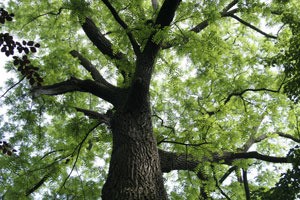
Highly prized for its strength, resistance to decay, handsome wood grain, and product versatility (it's made into everything from furniture to airplane propellers) to woodworkers, black walnut trees are considered black gold. To us gardeners, however, black walnut trees can prove to be a difficult landscaping challenge.
Black walnut trees (Juglans nigra) are alleopathic, a term used to describe plant species that have beneficial or harmful chemical effects on other plants. In the case of black walnut trees, the allelopathic interaction is harmful. The toxin responsible is called juglone, and resides in large amounts in the tree's roots. Juglone is known to inhibit respiration, resulting in stunted or deformed growth, and even death, in juglone-sensitive plants. Related species such as the English walnut (Juglans regia) and butternut (Juglans cinerea) tree are also alleopathic, although to a lesser extent.
Allelopathic interactions are complex and scientists are still conducting studies to fully understand the process.
Plants suffering from juglone toxicity may show a variety of symptoms. The extent of damage depends on the resistance of individual plants and the amount of contact with the toxin. It's believed that susceptible plants need to come within 1/4" - 1/2" proximity to the walnut tree's roots for serious damage to occur, but even a minor amount of contact with decaying leaf litter, nut husks, or rain drops containing juglone is also thought to harm some extremely sensitive plants.
Avoid Tree Removal: Cutting down your black walnut trees is not a good solution to your landscaping woes. At least not if your tree is healthy. Juglone is not very water soluble and will stay in the soil (and any tiny feeder roots not removed) for several years. Black walnut trees provide wonderful shade, reduce CO2 while providing fresh oxygen, produce food and shelter for backyard wildlife and birds, and make an excellent windbreak due to the strength of their wood.
Create Some Distance: The roots of a large black walnut tree can extend far beyond the reaches of its canopy. There is no magic safe distance for planting, but suffice to say, the farther away the better. When in doubt, make sure you experiment with cheaper plants.
Growing In Containers: Many gardeners have found great success by growing susceptible plants above ground in attractive containers. This is your opportunity to get creative and experiment with different planters and containers.
Clean Up Tree Debris: Leaf litter and nut husks contain only very small concentrations of juglone, but it's better to play it safe than be sorry by keeping the area around your tree raked up and free from fallen debris. If trimmed branches or bark are shredded for mulch, be sure to use them only on juglone resistant plants.
Plants from the nightshade family (Solanaceae) seem especially susceptible to the effects of juglone. This includes eggplants, cabbage, green peppers, potatoes, and tomatoes.
Other susceptible plants include: Azalea, rhododendron, cotoneaster, potentilla, apple, blackberry, blueberry, cucumber, grapes (domestic), crocus, peony, black alder (Alnus); basswood; white birches; Hopa crabapple; hackberry; Amur honeysuckle; Japanese larch; lespedeza; lilac; saucer magnolia; silver maple; mountain laurel; loblolly pine; red pine; scotch pine; white pine; privet; Norway spruce; and alfalfa.
There is a lot of conflicting information on which plants can be grown under black walnut trees. Plants on this list that require full sun can be grown near black walnut trees rather than beneath them. This list is meant as a general guide and it by no means complete (nor is the list above of plants to avoid). As stated earlier, allelopathic interactions are complex and your own experience may prove different depending on individual soil conditions, climate, etc.
Vegetables
Lima beans; snap beans; beets; carrots; corn; onions; melons; parsnips; and squash.
Landscape Plants
Red cedar; crabapple*; elm; winged euonymus; forsythia; hawthorn; hemlock; hickories; black locust; maples (most species); oaks; autumn olive; pachysandra; paw paw; persimmon; wild rose; sycamore; most viburnums; and Virginia creeper.
Fruits
Cherries and black raspberries
Flowers and Herbaceous Plants
Astilbe; bee balm; wax begonia; bellflower; bloodroot; bluebells; Kentucky bluegrass; coral bells; cranesbill; crocus*' daffodil; Shasta daisy; daylily; Dutchman's britches; ferns; fescue; hollyhock; glory-of-the-snow; hosta; iris; Jack-in-the-pulpit; lamb's ear; liriope; lungwort; pansies; pot marigold; morning glory; narcissus; phlox; sedum; Siberian squill; snowdrop; spiderwort; spring beauty; sundrops; sweet woodruff; trillium; violets; and zinnia.
* Conflicting information available so it appears on both lists.

About The Author: Ellen Brown is an environmental writer and photographer and the owner of Sustainable Media, an environmental media company that specializes in helping businesses and organizations promote eco-friendly products and services. Contact her on the web at http://www.sustainable-media.com
Add your voice! Click below to comment. ThriftyFun is powered by your wisdom!
I had no idea! This was a very informative post. I have a black walnut and an English walnut. I've had some trouble under the black walnut- This could be why. Thank you!
I have a huge black walnut and I find my irises are doing well in a raised garden underneath its branches. They get filtered light.
We have about ten burning bushes nearby that have done well.
I just wanted to say that we have black walnuts ALL over our yard. We have a garden that has black walnuts on 2 sides... 4 or 5 trees. We grow green peppers, tomatoes, and cucumbers (listed in the do not grow) every year and they do very well!
Add your voice! Click below to comment. ThriftyFun is powered by your wisdom!